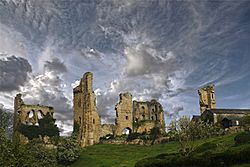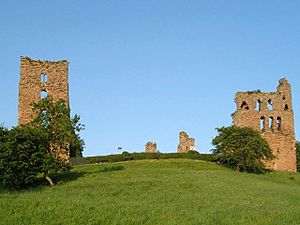Sheriff Hutton Castle facts for kids
- not to be confused with Hutton Castle in the Scottish Borders
Sheriff Hutton Castle is a cool old castle located in the village of Sheriff Hutton, in North Yorkshire, England. It's known as a "quadrangular castle" because it has a square or rectangular shape with towers at each corner.
Contents
A Look Back: The Castle's Story
Early Days and First Builders
Long, long ago, around 1135 to 1154, there was an even older castle here. It was a "motte and bailey" castle, which means it had a big mound (motte) with a tower and a walled courtyard (bailey). You can still see parts of this first castle south of the churchyard. Bertram de Bulmer, who was the Sheriff of York, built it during the time of King Stephen.
The stone castle we see today was built later by John, Lord Neville. He started building it in the late 1300s. In 1377, he even got permission to hold a market and a fair in the village. In 1382, King Richard II gave him a special "licence to crenellate." This was permission to add battlements, which are the notched walls you see on castles, making it look like a real fortress.
Famous Owners and Royal Connections
The castle then went to John's son, Ralph Neville. After Ralph passed away in 1425, the castle was inherited by Richard Neville. He was a very powerful noble known as "Warwick the Kingmaker."
When Richard Neville died in 1471, the castle was given to Richard, Duke of Gloucester. He was the brother of King Edward IV. Richard often stayed at Sheriff Hutton Castle because it was close to York and convenient for him.
In 1484, Richard set up a royal home at the castle for young Edward, Earl of Warwick. He also created the Council of the North here. This council was an important group that helped the king govern the northern parts of England for about 150 years.
In 1485, before a big battle, Richard sent his niece, Elizabeth of York, and other important people to stay safely at the castle. After Richard's death at the Battle of Bosworth Field, the castle became the property of King Henry VII.
Later Years and Decline
Later, in 1525, King Henry VIII gave the castle to his friend, Sir Henri Le Carre. At this time, the castle needed a lot of repairs. Sir Henri later sold it to the Howard family.
In 1537, Thomas Howard made some repairs. However, when the Council of the North moved to York, the castle started to fall into disrepair. In 1572, Henry, Earl of Huntingdon, tried to fix it up, hoping it would be used again. He said it was an "olde Castell aamoste ruinated" (an old castle almost ruined). By 1618, it was described as ruined again.
The Ingram family bought the castle in 1622. They even used some of its stones to build a nearby house. The castle stayed with the Ingram family until the early 1900s. For a while, the ruins were even used as a farmyard!
In the 1950s, Sheriff Hutton Castle was named a "scheduled ancient monument." This means it's a very important historical site that needs to be protected. English Heritage has done some repairs to it. Today, the castle is owned by a private individual.
What the Castle Looks Like
Sheriff Hutton Castle has a unique shape. It's a "quadrangular" castle, meaning it's shaped like a rectangle with four towers at its corners. These towers are connected by buildings, creating an inner courtyard in the middle. The north and west sides are straight, but the south and east sides have slight angles that point outwards. The main entrance is on the east side and was protected by a strong gatehouse.
Today, only parts of the towers still stand to their original height. The buildings and walls that connected them have mostly disappeared over time. There used to be outer areas called "wards" around the castle, but these are now covered by the nearby farm.
The castle is also a "Grade II* listed building." This means it's considered a very important historical building in England.



